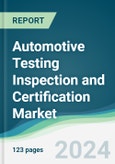The automotive testing inspection and certification market is evaluated at US$25.582 billion for the year 2022 growing at a CAGR of 4.92% reaching the market size of US$34.317 billion by the year 2029.
The automotive testing, inspection, and certification (TIC) services are used to provide automotive TIC producers with services to improve efficiency, productivity, and the production process to achieve the requirements. Furthermore, the use of smart sensors in vehicles, such as radar, light detection and ranging, and others, has enabled remote monitoring and prediction of maintenance capabilities, reducing the need for on-site inspection. As a result, technological developments in TIC, like virtual reality (VR) and augmented reality (AR), will aid in the replacement of physical vehicle inspection with digital inspection. Hence, the replacement of physical inspection with digital inspection and predictive maintenance is projected to fuel the worldwide automotive testing, inspection, and certification market growth.However, the automotive testing, inspection, and certification market has certain limitations that are expected to obstruct the market's potential growth, such as varying regulations or standards across regions and declining global vehicle sales, while the long lead time required for overseas qualification tests can challenge the market’s growth.
MARKET DRIVERS:
Rise in automobile manufacturing.
The rise in automobile manufacturing in emerging nations, as well as the quick shift in attitude toward outsourcing TIC services, are significantly affecting the automotive testing, inspection, and certification market growth. The increasing disposable incomes in emerging nations, and the increased focus of governments on imposing rigorous regulatory requirements on the automobile sector, are expected to fuel the automotive testing, inspection, and certification market expansion. Furthermore, the use of automotive electronics to ensure passenger and vehicle safety is projected to drive the automotive testing, inspection, and certification market growth during the forecast period.Increasing focus on automobile safety and quality.
The global automobile industry is supervised by a variety of government rules regulating passenger safety as well as environmental issues (emission levels, fuel economy, noise, and pollution). These regulations/standards have a direct impact on and affect the design of automotive parts. Strict government regulations require automakers to include safety equipment like seatbelts, airbags, and crumple zones in their vehicles. Major regulatory organizations impose tariffs and other trade obstacles to penalize and deter producers from violating pollution and safety standards, such as the continuous use of faulty equipment. This compels automakers to create fuel-efficient vehicles with significantly lower emissions, as well as add safety features such as anti-skid braking systems (ABS), electronic brake-force distribution (EBD), airbags, and emission control systems such as catalytic converters with turbochargers and exhaust gas recirculation (EGR) systems.MARKET RESTRAINTS:
Regulations and/or standards differ across regions.
With the globalization of trades and companies, specific regional regulations and standards are likely to create hurdles to product adoption on a global scale. This leads to disputes between local and international standards, impeding market expansion. Variations in regulatory requirements across different regions result in disparities in tax rates, incurring additional expenditures for businesses (hiring local staff to handle tax-related issues, etc.). Local regulations apply to TIC businesses, and they are required to obey the laws and norms of the countries in which they operate, which might limit their efficiency.The Asia Pacific automotive testing inspection and certification market is anticipated to grow significantly.
The Asia Pacific holds the majority of the global market and is expected to maintain its dominance during the projected period. The developing economies in this region, rising per capita income, rising demand, and more investment possibilities due to favorable government policies are attracting the attention of automobile manufacturers, who are looking to expand their production capacity in this region. This, in turn, leverages the technological revolution of the automobile production and service industries, resulting in the region's strong market growth. Furthermore, rising auto sales and production, rising demand for premium and autonomous vehicles, rising inclination toward electric cars, stringent government policies for vehicle safety and quality, and technological advancement in the automotive industry are encouraging automakers to expand in the market, thereby boosting automaker growth. As a result, it boosts the automotive testing inspection and certification market growth.Key Developments:
- In October 2023, Kugler Maag Cie by UL Solutions announced the expansion of its Automotive SPICE® capabilities in Mexico and Brazil. These new products include development workshops, training, assessments, and assistance for process optimization. Kugler Maag Cie by UL Solutions is a global supplier of process excellence, evaluation, and training solutions that assist the automobile industry. It is part of UL Solutions' automotive portfolio.
- In March 2023, the eReformas digital platform was created by Applus+, a well-known Spanish multinational in the vehicle inspection industry with over 13 million inspections performed annually across 11 countries, to enhance the PTI test user experience in Spain.
Segmentation:
By Service
- Testing
- Inspection
- Certification
By Sourcing
- Outsourced
- In-house
By Application
- Telematics
- Electrical Systems & Components
- Interior & Exterior Material
- Homologation Testing
- Others
By Geography
- North America
- United States
- Canada
- Mexico
- South America
- Brazil
- Argentina
- Others
- Europe
- UK
- France
- Germany
- Italy
- Others
- Middle East and Africa
- Saudi Arabia
- UAE
- Others
- Asia Pacific
- Japan
- China
- India
- Thailand
- Taiwan
- Indonesia
- Others
Table of Contents
1. INTRODUCTION
2. RESEARCH METHODOLOGY
3. EXECUTIVE SUMMARY
4. MARKET DYNAMICS
5. AUTOMOTIVE TESTING INSPECTION AND CERTIFICATION MARKET BY SERVICE
6. AUTOMOTIVE TESTING INSPECTION AND CERTIFICATION MARKET BY SOURCING
7. AUTOMOTIVE TESTING INSPECTION AND CERTIFICATION MARKET BY APPLICATION
8. AUTOMOTIVE TESTING INSPECTION AND CERTIFICATION MARKET BY GEOGRAPHY
9. COMPETITIVE ENVIRONMENT AND ANALYSIS
10. COMPANY PROFILES
Companies Mentioned
- Bureau Veritas S.A. (Wendel)
- SGS SA
- Dekra Group
- Intertek Group Plc
- TUV SUD
- BSI Group
- TUV Nord Group
- ATIC
- Applus+
- NTS








